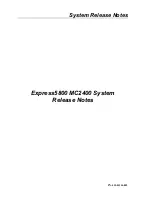
Chapter 4. Appliance configuration programs
17
families. However, the Advanced Appliance Configuration Utility will discover
connected appliances and their network settings.
The Advanced Appliance Configuration Utility agent
After your appliance is connected to your network, the Advanced Appliance
Configuration Utility agent automatically reports the appliance MAC address (of the
first NIC only), serial number, and type of appliance. Furthermore, it will report the
host name, primary IP address, subnet mask, primary DNS address, and primary
gateway address if these are configured on the system.
The Advanced Appliance Configuration Utility agent is preinstalled on your xSeries
appliance.
Note:
The Advanced Appliance Configuration Utility agent periodically broadcasts
the appliance server IP settings. To prevent the service from broadcasting this
data periodically, stop the Advanced Appliance Configuration Utility service.
The Advanced Appliance Configuration Utility console
The Advanced Appliance Configuration Utility console is a Java application that you
install on one system in your network to be used as a systems management console.
For information on how to install the Advanced Appliance Configuration Utility
console, see “Using the Supplementary CD” on page 24.
Note:
Do not install the Advanced Appliance Configuration Utility console on more
than one systems-management console.
The Advanced Appliance Configuration Utility console enables you to:
•
Automatically discover appliance servers that run the Advanced Appliance
Configuration Utility agent and are attached to the same physical subnet as the
Advanced Appliance Configuration Utility console.
When you start the Advanced Appliance Configuration Utility console, it
automatically detects all appliance servers on your physical subnet that are
running the Advanced Appliance Configuration Utility agent.
•
Use a simple, GUI-based application to configure the appliance servers network
settings.
Use the Advanced Appliance Configuration Utility to assign IP addresses, DNS
and gateway server addresses, subnet masks, host names, and more.
•
Automatically group discovered appliances into function-specific families.
Appliances are added to a family based on the appliance type. Appliances
running different operating systems but performing the same function appear in
the same family.
•
Start Appliance System Manager management console.
Launch Appliance System Manager on your appliance server and perform
advanced systems management tasks on a selected appliance server with a
single mouse click.
Summary of Contents for eServer xSeries 135
Page 3: ...IBM IBM xSeries 135 Appliance Server Installation Guide...
Page 8: ...vi IBM xSeries 135 Appliance Server Installation Guide...
Page 18: ...10 IBM xSeries 135 Appliance Server Installation Guide...
Page 60: ...52 IBM eServer xSeries 135 Appliance Server Installation Guide...
Page 61: ......
Page 62: ...IBM Part Number 24P1892 Printed in the United States of America 24P1892...
















































